Industrial Insulation Market Overview:
The global industrial insulation market size was valued at $7.8 billion in 2021, and is projected to reach $12.7 billion by 2031, growing at a CAGR of 5.1% from 2022 to 2031. The industrial insulation market has grown due to the rise in demand for energy efficiency and the increase in trend of industrial automation & infrastructure development. As industries seek to reduce energy consumption and operating costs, insulation plays a key role in minimizing heat loss and improving thermal management. In addition, the expansion of industrial automation and infrastructure further drives the need for effective insulation solutions in manufacturing and processing facilities.
Key Market Insights
- By Material, The mineral wool segment led the global industrial insulation market by revenue in 2021.
- By End Use Industry, Oil & gas led the global industrial insulation market due to high use in equipment temperature control.
- By Region, Asia-Pacific led the market in 2021 and is set for strong growth ahead.
Market Size & Forecast
- 2031 Projected Market Size: USD 12.7 Billion
- 2021 Market Size: USD 7.8 Billion
- Compound Annual Growth Rate (CAGR) (2022-2032): 5.1%
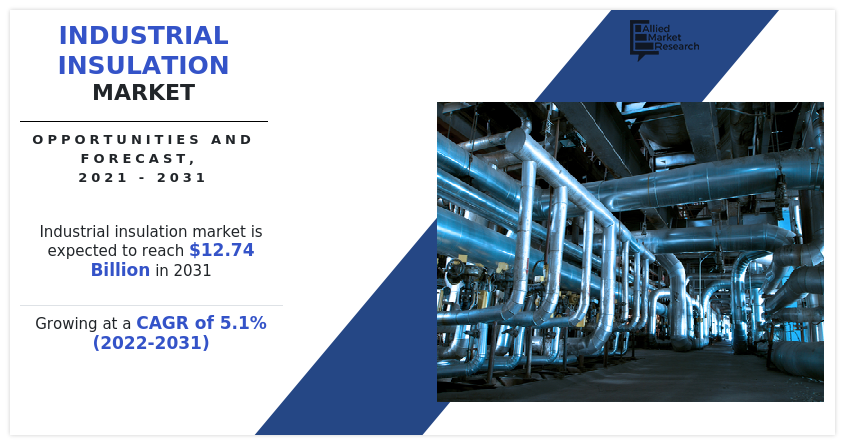 How to Describe Industrial Insulation
How to Describe Industrial Insulation
Industrial insulation refers to the materials and systems used to reduce heat transfer, noise, and energy loss in industrial settings. It is applied to equipment, pipes, boilers, and ducts to improve energy efficiency, maintain desired temperatures, and prevent heat-related damage. Industrial insulation materials include fiberglass, mineral wool, calcium silicate, and foam, each chosen based on specific temperature, chemical, and acoustic requirements. Insulation enhances safety, reduces energy consumption, and minimizes environmental impact by controlling heat flow. It is essential in industries such as manufacturing, power generation, and chemical processing, where temperature control and energy savings are critical for operational efficiency.
How are Market Dynamics Shaping Industry Competition
Increase in demand for enhancing equipment efficiency and process performance among application industries is expected to serve as a crucial growth factor for the industrial insulation market. Also, increase in demand for industrial insulation due to rise in construction, industrial, and infrastructure activities globally, and the growing demand for energy conservation further propel the industrial insulation market. Further, industrial insulation has been used to safeguard boilers, furnaces, chimneys, temperature storage tanks, and other power sector equipment. It is a vital part of power plant installation and operation. It assists steam-generating boilers in maintaining specific temperatures. Consequently, the increasing demand from boilers, furnaces, chimneys, and temperature storage tanks industry of insulation coupled with growth in power industry is predicted to surge the demand for industrial insulation during the forecast period.
Moreover, the industrial insulation industry is heavily influenced by the needs of oil and gas, steel, manufacturing, electricity, and other industries operating on high temperature or radiant systems. The expanding industrial sector and associated stringent safety and emission standards are expected to stimulate demand for industrial insulation. In addition, companies are focused on improving performance by reducing losses by adhering to regular maintenance practices that often require insulation replacement. This practice is expected to accelerate market growth during the forecast period.
However, high initial installation cost restrains the growth of the industrial insulation market. The expenses associated with purchasing and installing insulation materials, along with labor and equipment, are substantial, especially for large-scale projects. This financial burden deters businesses, particularly small and medium enterprises, from investing in industrial insulation. Despite long-term energy savings and efficiency benefits, the high upfront cost remains a key challenge, limiting broader adoption and market growth.
Industrial Insulation Market Segment Review:
The industrial insulation market is segmented into material, form, end-use industry, and region. By material, the market is categorized into mineral wool, plastic foam, and others. On the basis of form, the market is categorized into pipe, blanket, board, and others. On the basis of end-use industry, the market is categorized into power, oil and gas, chemical and petrochemical, cement, food & beverage, and others. Region-wise, the market is studied across North America, Europe, Asia-Pacific, and LAMEA. The industrial insulation market share is analyzed across all significant regions and countries.
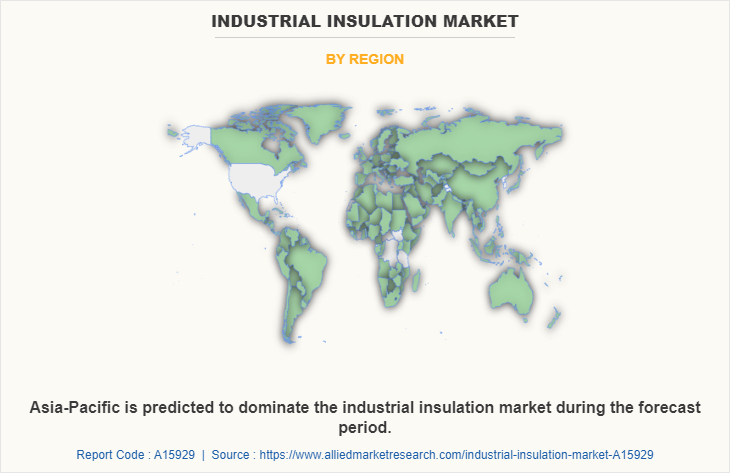
Industrial Insulation Market By Region
Region-wise, Asia-Pacific dominated the market with the highest revenue share in 2021. Asia-Pacific is projected to register a robust growth during the forecast period. This growth is attributed to the rapid growth in the automotive, construction, and telecommunications sectors in the region. In addition, low labor costs, production unit installation costs, and low insulation costs are driving the market.
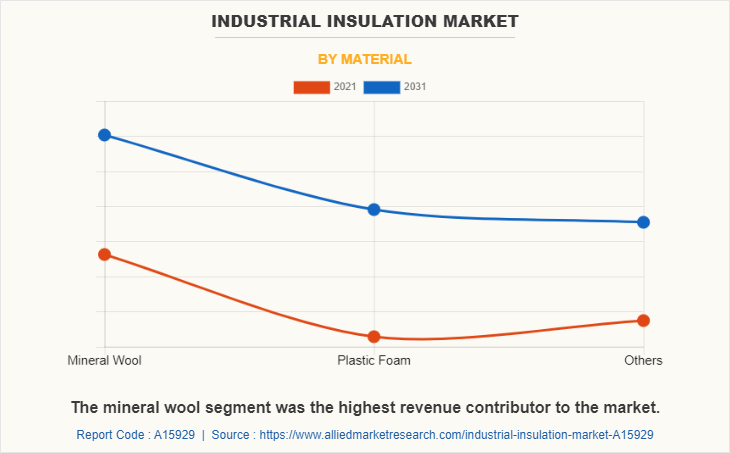
Industrial Insulation Market By Material
On the basis of material, the mineral wool segment dominated the global industrial insulation market in terms of revenue, in 2021. Mineral wool insulation is an insulator that is widely used in the piping and construction industries. Mineral wool insulation is a poor thermal conductor, and has superior flame-resistant properties. Besides, it is also used as an acoustic dampener. These factors are predicted to surge the demand for mineral wools during the forecast period.
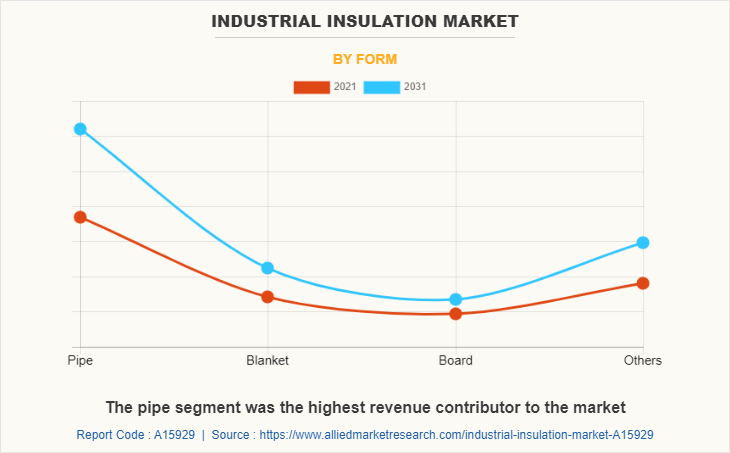
Industrial Insulation Market By Form
On the basis of form, the pipe segment dominated the global industrial insulation market in terms of revenue, in 2021. Pipe insulation has been a prominent shift in the market towards the development of environment-friendly insulation materials and the utilization of recycled products. With continuous increase in environmental concerns, manufacturers are increasingly adopting eco-friendly alternatives for insulation materials, such as cellulose, mineral wool, and more. These factors are predicted to surge the demand for insulated pipes during the forecast period.
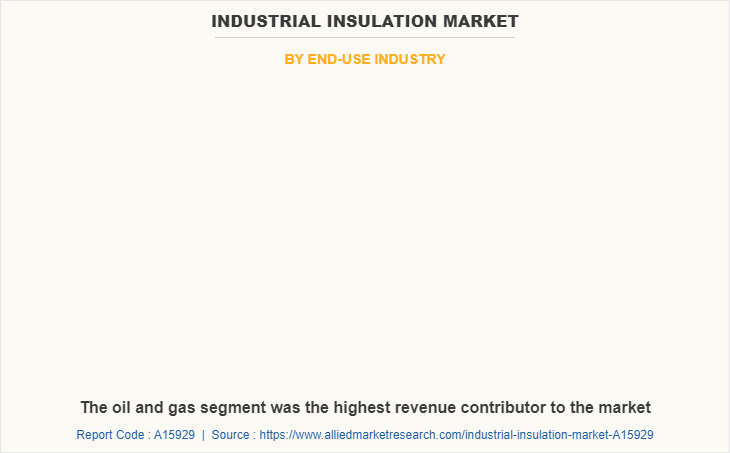
Industrial Insulation Market By End Use Industry
On the basis of end-use industry, the oil and gas segment dominated the global industrial insulation market owing the extensive use of industrial insulation materials in maintaining equipment temperatures. The increasing usage of oil and gas for energy, growing population, and rise in demand for petrochemicals are driving the segment growth.
Which are the Leading Companies in Industrial Insulation
The key players operating in the industrial insulation industry. The players have adopted several strategies such as product launch and business expansion to sustain the market competition.
Armacell International SA
BASF SE
Cabot Corporation
Johns Manville
Kingspan Group PLC
Knauf Insulation
Nichias Corporation
NMC Group
Owens Corning
Polyguard Materials Inc.
Promat
Rockwool Group
Saint Gobain
Solvay
Thomas Insulation Corporation.
Emerging Trends & Developments
In September 2024, Armacell, a leader in flexible foam and engineered foams, announced the launch of a new advanced aerogel technology. This innovation is expected to expand the company’s ArmaGel product range, enhancing its offerings in the insulation market. The new aerogel-based products are expected to provide improved performance, supporting Armacell’s continued growth and leadership in the equipment insulation sector.
In December 2022, Dow launched V PLUS Perform next, an upgraded version of its V PLUS Perform polyurethane technology for insulated metal panels. This new product combines the energy efficiency and fire safety features of the original with low-carbon and circular ingredients, customized to meet customer specifications, providing an eco-friendly and high-performance solution for building insulation.
What are the Key Benefits For Stakeholders:
- This report provides a quantitative analysis of the market segments, current trends, estimations, and dynamics of the industrial insulation market analysis from 2021 to 2031 to identify the prevailing industrial insulation market opportunities.
- The market research is offered along with information related to key drivers, restraints, and opportunities.
- Porter's five forces analysis highlights the potency of buyers and suppliers to enable stakeholders make profit-oriented business decisions and strengthen their supplier-buyer network.
- In-depth analysis of the industrial insulation market segmentation assists to determine the prevailing market opportunities.
- Major countries in each region are mapped according to their revenue contribution to the global market.
- Market player positioning facilitates benchmarking and provides a clear understanding of the present position of the market players.
- The report includes the analysis of the regional as well as global industrial insulation market trends, key players, market segments, application areas, and market growth strategies.
Industrial Insulation Market Report Highlights
| Aspects | Details |
| By Material |
|
| By Form |
|
| By End-use Industry |
|
| By Region |
|
| Key Market Players | Cabot Corporation, Rockwool group, Armacell International SA, Promat, Thomas Insulation, Kingspan Group PLC, NMC, Nichias Corporation, Saint Gobain, Solvay, Johns Manville, Knauf Insulation, Polyguard materials, Owens Corning, BASF SE |
| Other Key Market Players | General Coatings Manufacturing Corp |
Analyst Review
The industrial insulation market is anticipated to grow in near future due to its extensive use in applications, such as power, oil and gas, chemical and petrochemical, cement, food and beverage, and other end-use industries. The Asia-Pacific region is projected to register a robust growth during the forecast period.
Industrial insulation has been used to safeguard boilers, furnaces, chimneys, temperature storage tanks, and other power sector equipment. It is a vital part of power plant installation and operation. It assists steam-generating boilers in maintaining specific temperatures. Consequently, increase in demand from boilers, furnaces, chimneys, and temperature storage tanks industry of insulation and growth in the power industry are predicted to surge the demand for industrial insulation during the forecast period.
The industrial insulation market was valued at $7.8 billion in 2021, and is projected to reach $12.7 billion by 2031, growing at a CAGR of 5.1% from 2022 to 2031.
Asia-Pacific dominated the market with the highest revenue share in 2021.
The major players operating in the global industrial insulation market include, Armacell International SA, BASF SE, Cabot Corporation, Johns Manville, Kingspan Group PLC, Knauf Insulation, Nichias Corporation, NMC Group, Owens Corning, Polyguard Materials Inc., Promat, Rockwool Group, Saint Gobain, Solvay, and Thomas Insulation Corporation.
Oil and gas is the leading application of Industrial Insulation Market.
Increase in demand for enhancing equipment efficiency and process performance among application industries is expected to serve as a crucial growth factor for the industrial insulation market. Also, increase in demand for industrial insulation due to rise in construction, industrial, and infrastructure activities globally, and the growing demand for energy conservation further propel the industrial insulation market.
Loading Table Of Content...



